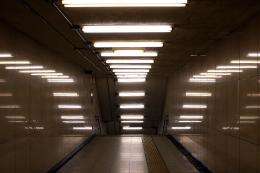July 28, 2012 weblog
Fluorescent lights keep smartphones from ten-second drifts

(Phys.org) -- One obvious way to reset a mobile device's clock is to check out a master clock online but Zhenjiang Li, a computer scientist and doctoral candidate at Hong Kong University of Science and Technology, and colleagues have another way of keeping devices time-worthy. Li and co-authors from universities in China, Singapore, and Illinois, have demonstrated that any mobile device, including a smartphone, that has a light sensor or camera can use the flicker from fluorescent lights to keep accurate time. They have authored a paper titled, "FLIGHT: Clock Calibration Using Fluorescent Lighting," to explore how smartphone clocks can keep precise time via the flicker of fluorescent lights.
“Starting from static deployment in the laboratory, our measurements validate that fluorescent lighting is able to serve as a viable reference for time calibration,” they wrote.
Most electronic devices use vibrating crystals to regulate their internal clocks. External factors like humidity and temperature, however, can throw off these frequencies to the point where the clocks “drift,” and that drift may be by nearly ten seconds per day, in some devices.
The team calls their new clock synchronization approach FLIGHT, which makes use of the fact that the light intensity from fluorescent lamps varies with a stable period. FLIGHT does not require any extra hardware and radio operations, noted the authors. By sampling a light sensor or camera, FLIGHT can intelligently extract periods for the clock calibration and retain a common notion of time in the system.
By tuning to the light emitted from indoor fluorescent lamps, FLIGHT can intelligently extract the light period information and achieve network wide time calibration by referring to such a common time reference. The researchers said they implemented FLIGHT in TelosB motes. Their experiments used a 12-node test-bed in static and mobile environments.
“Over one-week measurement suggests that, compared with existing technologies, FLIGHT can achieve tightly synchronized time with low energy consumption,” they stated. The researchers think their scheme is accurate to less than a thousandth of a second per day. Since it needs no network connection, they note that the approach carries the benefit of saving a device’s battery life.
The team is to present this work at the MobiCom conference (the 18th Annual International Conference on Mobile Computing and Networking) in Istanbul, Turkey, from August 22 to August 26. MobiCom is a gathering of professionals focused on both mobile computing and wireless and mobile networking. Talks and presentations will address networks, systems, algorithms, and applications that support “the symbiosis of mobile computers and wireless networks.”
Based on the discussion in the authors' paper, there can be an easy and useful relationship between wireless devices and fluorescent lights. They point out that the light sensor or camera has been widely embedded in commodity wireless platforms. This, they suggest, offers a great opportunity for plenty of indoor applications to maintain common time by referring to the light emitted from fluorescent lamps. The fluorescent lights in the home or office are actually flickering at regular intervals, though it may be too rapid a flicker for the eyes to notice.
Reactions by science writers elsewhere have reacted favorably to the concept. “Artificial lighting is all around us, and it is a fantastic keeper or time,” said PopSci. “Alternating current provided by power mains runs at a frequency of 50 or 60 cycles per second, with the power delivered dropping to zero twice per cycle.”
More information: www.cse.ust.hk/~lzjiang/2012-MobiCom_FLIGHT.pdf
via Newscientist, Popsci
© 2012 Phys.org



















